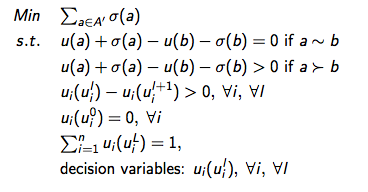Synthesis criterion
Mis à jour :
1. Introduction
The multicriteria principle of synthesis criterion aims at building a function $g$ synthesizing all criteria:
Such approach allows for
- Pre-order on the set of alternatives $A$
- Compare alternatives
- Choose among them
- Rank them
- Assign them to classes
Nonetheless, building $g$ is often difficult and requires a big amount of preference information from the decision-maker.
In particular, we should focus on its two aspects:
- Which properties should the decision-maker preferences possess so as to be representable by a $g$ function?
- How to build $g$ and set the values to the parameters involved in the chosen parametric form?
1.1. Weighted sum
It is the simplest and the most used analytic form, The function g takes the following analytic form:
and the corresponding structure is:
1.2. Multi-attribute value model
This weighted sum can be generalized to non-linear operations for the preferences on a criteria. It is the role of the Multi-Attribute Value Theory, which takes the following form:
with $u(a) = f(g_{1}(a),g_{2}(a),…,g_{n}(a))$.
A frequently encountered case is the additive form of the MAVT:
with $u_{i}(g_{i}^{\text{min}}) = 0$, $u_{i}(g_{i}^{\text{max}}) = 1$ and normalized weights.
2. Constructing value functions
To specify an additive MAVT model, one should elicit marginal value functions $u_{i}$, $\forall i \in F$ and “weights” $w_{i}$, $\forall i \in F$. In particular, we are interested in eliciting:
- Value function $u_{i}$ (for each criterion).
- Weight vector $w_{i}$.
2.1. Elicitation of value function $u_{i}$
Method 1: convenient when the evaluation scale $E_{i}$ is finite.
- Rank elements of $E_{i}$
- Rank differences between consecutive elements in the preceding ranking
- Assign values compatible with the information obtained at step 1. and 2.
2.2. Eliciting importance coefficients $w_{i}$
Consider $b_{j}$ an alternative such that $g_{i}(b_{j}) = g_{i}^{\text{min}}$ , $\forall i \neq j$ and $g_{j}(b_{j}) = g_{j}^{\text{max}}$.
- Rank $b_{j}$ , $j \in F$ by order of preference,
- Reorder criteria such that $b_{n} \succ . . . \succ b_{1}$, we induce that $w_{n} \geq …\geq w_{1}$
Now consider $b_{j}^{n}$ such that $g_{i}(b_{j}^{n}) = g_{i}^{min}\ \forall i \neq n$ and $g_{i}(b_{j}^{n}) = x$.
3 Determine g_{n}(b_{n}(j)) such that $b_{1} \sim b_{n}^{j}$ to obtain:
Finally, we obtain: $\frac{w_{1}}{w_{n}} = u_{n}(x)$ or $u_{n}(g_{n}(x))$
Repeat for all $g_{2}, …, g_{n-1}$
Hence we obtain the ratios $\frac{w_{i}}{w_{n}},\ i = 1, …, n−1$
TODO: Revoir notations! Indices tout ca!
2.3. UTA
TODO: Add image
The goal of UTA is to:
- Define a ranking on a subset of alternatives $(a_{2} \succ a_{1} \succ a_{6} \succ a_{8})$.
- Define a linear program which minimizes an error function and infers an additive value model compatible with the stated ranking.
- Based on this inferred additive value model, rank order all alternatives.
3. Inferring a value function
Searched model: $u(a) = \sum_{i=1}^{n} u_{i} (g_{i} (a))$ with $u_{i}$ piecewise linear marginal value function.
If $z ∈[g_{i}^{l}, g_{i}^{l+1}]$ then:
$A’$ is a subset of alternative ranked by the decision-maker Inferred value $u’$: $u’(a) = u(a) + \sigma(a), \forall a ∈ A’$ where $\sigma(a)$ is the error in the estimation of $u(a)$.
TODO: Custom program


Laisser un commentaire